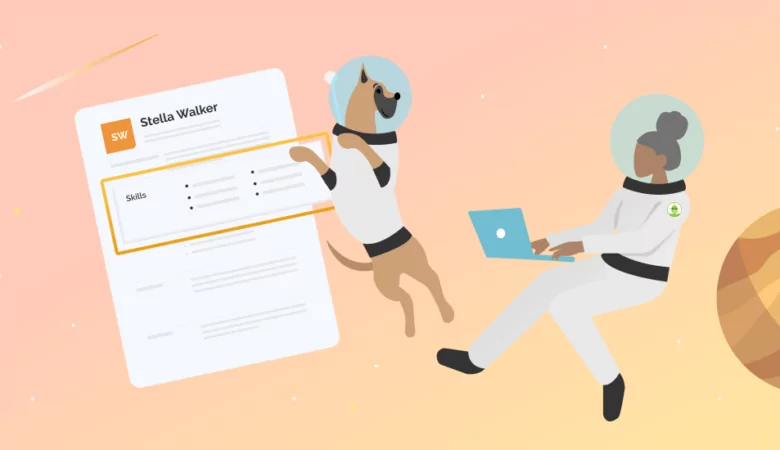Follow these five easy steps for what to put on your resume. Learn what goes into your resume that gives you the best shot at a job.

What to Put on Your Resume In Five Easy Steps
How to Make a Professional Resume
A good resume is key to impressing a hiring manager and getting an interview for the job you want. Follow these five easy steps to create the perfect resume for any job.
Five Easy Steps to Fill In Your Resume
The way your resume is organized is critical to your success in landing a job interview. There are certain sections hiring managers look for in a professional resume. By filling in these sections, you can ensure that your resume makes it past an Applicant Tracking System and one step closer to your dream job.
-
Place your contact information in the header of your resume.
Contact information should include:
- Full name
- Phone number
- Email address
- Physical address
- Professional profile links (optional)
-
Write a great resume summary or objective.
Include a resume summary or objective. This is a short statement that lets the hiring manager know why you are the perfect candidate. A resume summary focuses on work experience, while a resume objective focuses on career goals and relevant skills.
-
Use key words in your skills section.
Your skills section is one that the hiring manager is sure to look over carefully. You can enhance your chances of landing a job interview by using keywords from the job description (e.g., specific required skills) to describe your relevant skills. Include both soft skills and hard skills in this section to make the best impression. Soft skills include communication skills, problem-solving, and people skills. Hard skills include technical abilities like computer skills and techniques.
-
Use action verbs to describe your work experience.
The order of your work experience will depend on which resume format you choose to use.
In every format, your employment history should include the company name, the dates and location, and your job title. When listing your work experience, use bullet points to list a few examples of your tasks at each position. Using action verbs to describe your tasks and duties can emphasize your value as an employee. Examples of action verbs that are frequently used to describe work experience include:
- Leveraged
- Strategized
- Coordinated
- Programmed
-
Include the correct information about your education.
In the education section, many job seekers make the mistake of including too much or too little information. The education section should include:
- Highest level of education attended (e.g., high school, university, etc.)
- Highest degree achieved
- Field of study
- Relevant training or certifications
In some instances, you may choose to include relevant coursework if you have extra space on your resume. You do not need to include your GPA.
Finishing Your Resume
Your resume should fit on one page once it is finished. (The exception: if you’re applying for a job that requires extensive experience, it’s okay to write a resume two pages long to accommodate a longer work experience section). If your resume is slightly longer than one page, then try adjusting the content or format to shorten it. Use bullet points and short phrases instead of lengthy paragraphs, or try a resume builder or resume template to help. If your resume is too short, then you can add additional information to fill in the space. Some additional sections that hiring managers will find useful are:
- Certifications and professional licenses
- Awards and Achievements
- Languages
- Internships
- Volunteer work
Three Common Resume Mistakes
There are several common mistakes that job seekers make when creating their resumes. These three mistakes are made by new graduates as well as experienced job seekers:
-
Including biasing information.
Including a photo, your age or other personal information that may influence the hiring manager’s decision is not only inappropriate, but it may cause your resume to be thrown out before it is ever seen by a hiring manager at all. Many companies have strict anti-discrimination policies that dictate their hiring process.
-
Listing salary requirements on your resume.
Listing salary requirements on your resume is not necessary and may count you out of the job. It is better to obtain the job offer first and negotiate at that time.
-
Making your resume too long.
Many job seekers think listing more information is better. However, the best resume length is one single page. This will make it more likely that busy hiring managers will read your resume. Having a one-page resume also ensures that only the most relevant information is included.
FAQ: What To Put on a Resume
During your job search, you may receive career advice regarding the applicant tracking system or ATS. Many hiring managers and recruiters use the ATS to assist them in the hiring process. An ATS scans resumes and sorts them based on layout, keywords from the job posting, and other programmed elements. You can improve your chances of passing the ATS by:
- Using a standard resume format
- Using a clean and straightforward font and layout
- Using keywords and phrases from the job description
The best resume format to use depends on your years of experience and the type of job you are applying for. The chronological resume is the most popular resume format and is best if you already have professional experience. If you are new to the job market, then a functional resume format may be more beneficial. This type of resume focuses on relevant skills.
Yes, you can make a resume with these tips whether you are new to the job market or have extensive professional experience. You can make your resume stand out with relevant skills, certifications, and volunteer experience. There are even specific resume formats for those who don’t have much work experience.








